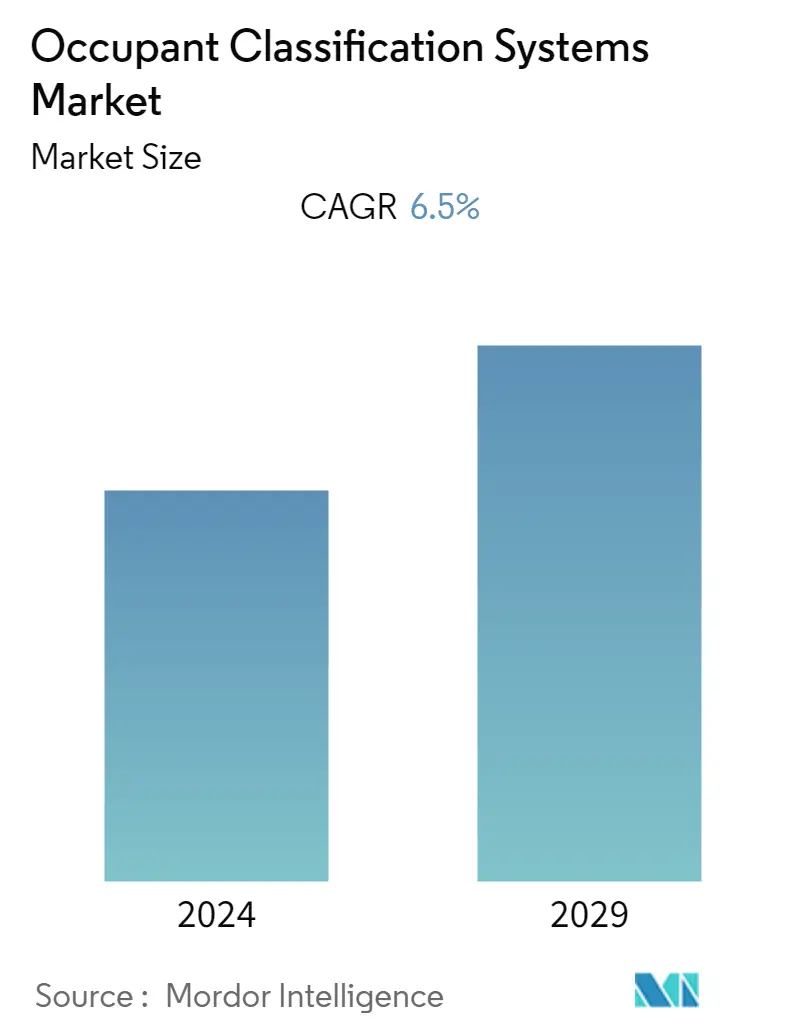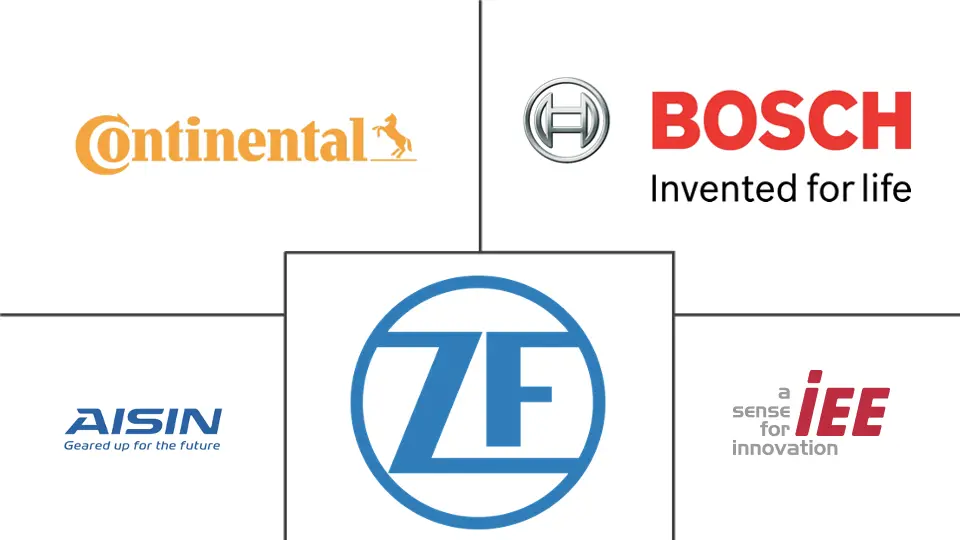Market Size of Occupant Classification Systems Industry

| Study Period | 2019 - 2029 |
| Base Year For Estimation | 2023 |
| CAGR | 6.50 % |
| Fastest Growing Market | Asia Pacific |
| Largest Market | North America |
| Market Concentration | Low |
Major Players
*Disclaimer: Major Players sorted in no particular order |
Occupant Classification Systems Market Analysis
The occupant classification systems (OCS) market is expected to witness a CAGR of 6.5% during the forecast period (2021 - 2026). OCS detects the existence and physique of the passenger seat occupant for the Advanced Air Bag requirements. This system distinguishes between gender, as well as children and adults, by their seating postures with the help of pressure sensors in the seat and tension on seat belts.
- The increasing demand for safety in automobiles is boosting the market's growth positively. For instance, according to the World Health Organization, globally, approximately 1.35 million people are killed in road accidents every year. Moreover, between 20 and 50 million more people suffer non-fatal injuries, with many incurring a disability as the result of their injury. OCS plays an important role in improving the safety features of vehicles.
- Additionally, the rising automotive sales and increasing production of autonomous vehicles worldwide are fueling the demand for inertial systems in the automotive industry. According to the OICA (Organisation Internationale des Constructeurs d'Automobiles), the sales of automotive worldwide, in 2019, reached 95 million units. Moreover, according to UBS, the global market for sensor semiconductor autonomous vehicles is expected to reach USD 30 billion by 2030. Such high growth in automotive sales is expected to further drive the demand for OCS in the forecast period.
- Asian countries, such as China, India, South Korea, Taiwan, Japan, who have a significant presence of manufacturers of the OCS, as well as the highest automotive market has experienced lockdown and have impacted the production schedules. The sales have been down as the lockdown in most of the global economies has been resulted in deliveries limited to essentials and has resulted in companies revising their revenue targets.
Occupant Classification Systems Industry Segmentation
The study of the occupant classification systems (OCS) market has considered the various offerings from the vendors for sensors and airbag systems, globally. The OCS systems enable the differentiation of passenger seating on the front passenger seat to assist advanced airbag safety systems.
| By Component | ||||
| Airbag Control Unit (ACU) | ||||
|
| By Vehicle Type | |
| Light Vehicles | |
| Electric Vehicles |
| Geography | |
| North America | |
| Europe | |
| Asia-Pacific | |
| Latin America | |
| Middle East & Africa |
Occupant Classification Systems Market Size Summary
The occupant classification systems (OCS) market is poised for significant growth, driven by the increasing emphasis on automotive safety and the rising production of autonomous vehicles. OCS technology plays a crucial role in enhancing vehicle safety by detecting the presence and physical characteristics of passengers, thereby optimizing airbag deployment. The market is further bolstered by stringent safety regulations and mandates from entities like the US Department of Transportation and the European Union, which are pushing automotive manufacturers to adopt advanced sensor-based systems. These regulatory frameworks aim to reduce road traffic fatalities and injuries, creating a favorable environment for the OCS market expansion.
The competitive landscape of the OCS market is characterized by the presence of established players such as IEE Sensing, Continental AG, and Robert Bosch GmbH, who leverage their brand reputation and technological advancements to maintain a strong market position. Recent strategic moves, such as TE Connectivity's acquisition of Silicon Microstructures Inc., highlight the industry's focus on enhancing sensor technology capabilities. Additionally, initiatives like Bosch's 'Connectory' in London underscore the industry's commitment to developing innovative mobility solutions. As the demand for advanced safety systems continues to rise, the OCS market is expected to experience robust growth, with Europe leading the charge due to its stringent safety regulations and high automotive sales.
Occupant Classification Systems Market Size - Table of Contents
-
1. MARKET DYNAMICS
-
1.1 Market Overview
-
1.2 Market Drivers
-
1.2.1 Emergence of MEMS Technology
-
1.2.2 Passenger Safety and Security Regulations and Increased Focus on compliance
-
-
1.3 Market Restraints
-
1.3.1 Integration Drift Error
-
-
1.4 Industry Value Chain Analysis
-
1.5 Porter's Five Forces Analysis
-
1.5.1 Threat of New Entrants
-
1.5.2 Bargaining Power of Buyers/Consumers
-
1.5.3 Bargaining Power of Suppliers
-
1.5.4 Threat of Substitute Products
-
1.5.5 Intensity of Competitive Rivalry
-
-
1.6 Assessment on the Impact of COVID-19 on the market
-
-
2. MARKET SEGMENTATION
-
2.1 By Component
-
2.1.1 Airbag Control Unit (ACU)
-
2.1.2 Sensors
-
2.1.2.1 Pressure Sensor
-
2.1.2.2 Seat Belt Tension Sensor
-
-
-
2.2 By Vehicle Type
-
2.2.1 Light Vehicles
-
2.2.2 Electric Vehicles
-
-
2.3 Geography
-
2.3.1 North America
-
2.3.2 Europe
-
2.3.3 Asia-Pacific
-
2.3.4 Latin America
-
2.3.5 Middle East & Africa
-
-
Occupant Classification Systems Market Size FAQs
What is the current Occupant Classification Systems Market size?
The Occupant Classification Systems Market is projected to register a CAGR of 6.5% during the forecast period (2024-2029)
Who are the key players in Occupant Classification Systems Market?
ZF Group, Continental AG, Aisin Seiki Co Ltd, Robert Bosch GmbH and IEE SENSING are the major companies operating in the Occupant Classification Systems Market.

